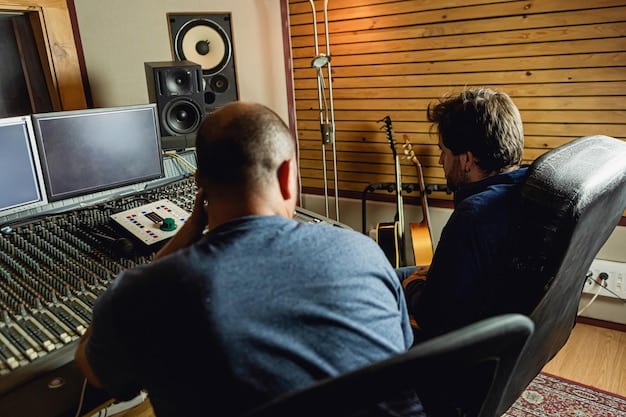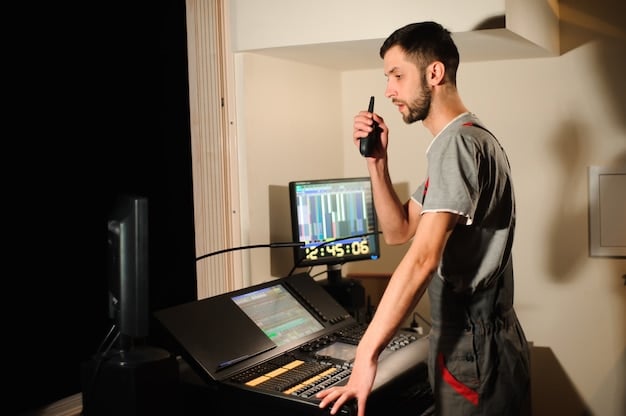Unveiling the Secrets: Director’s Guide to Ending Scene Music in 2025

Unveiling the Secrets: How Directors Choose the Perfect Ending Scene Music in 2025 delves into the intricate process where emotional resonance, narrative culmination, and audience impact converge, revealing how music elevates the final moments of a film, leaving a lasting impression.
The final scene of a film can make or break the entire experience. One crucial element that directors meticulously consider is the music that accompanies this pivotal moment. Delve into the secrets of Unveiling the Secrets: How Directors Choose the Perfect Ending Scene Music in 2025, exploring the creative and technical aspects that bring harmony to the screen.
The Evolving Role of Music in Cinema
Music has always been an integral part of filmmaking, but its role has evolved over time, especially concerning the ending scenes. It’s no longer just background noise; it’s a powerful storytelling tool that adds depth and emotion.
Historical Context of Ending Scene Music
Early cinema relied heavily on live music to enhance the viewing experience. As technology advanced, recorded scores became the norm, allowing for greater control and precision in matching music to the visuals.
The Shift Towards Emotional Storytelling
Modern directors are increasingly using music to amplify the emotional impact of the final scene. Rather than simply concluding the story, the music adds layers of meaning and encourages reflection.
- Creating Lasting Impressions: Music helps to etch the film’s ending into the viewer’s memory.
- Enhancing Emotional Depth: Music can evoke feelings that visuals alone cannot capture.
- Driving Narrative Closure: The right music provides a sense of resolution and completion.
The transformation of music’s role necessitates that directors understand its potential and consider it from the earliest stages of production. By 2025, this approach will be even more vital.
Understanding the Director’s Vision
A director’s vision is the guiding force behind every aspect of a film, including the music. Understanding this vision is crucial to selecting the perfect piece for the ending scene.

Communicating Artistic Intent
Directors must effectively communicate their artistic intent to composers and music supervisors. This involves discussing the themes, characters, and overall tone of the film.
Collaboration with Composers and Music Supervisors
The selection of ending scene music often involves close collaboration with composers and music supervisors. These individuals bring their expertise to the table, helping the director find the perfect match.
Effective communication is key to ensuring that the music aligns with the director’s vision. This may involve providing detailed briefs, sharing reference tracks, and engaging in open dialogue. The goal is to create a shared understanding of the desired emotional impact.
Key Factors Influencing Music Selection
Several factors influence a director’s choice of music for the ending scene. These range from the film’s genre and target audience to budgetary constraints and licensing considerations.
Genre and Audience Considerations
The genre of the film plays a significant role in determining the appropriate style of music. A somber drama will likely require a different approach than an action-packed blockbuster.
Likewise, directors must consider the target audience when selecting music. What resonates with one demographic may not have the same effect on another.
Budgetary and Licensing Constraints
Budgetary restrictions can limit the available options for ending scene music. Licensing fees for popular songs can be expensive, leading directors to explore alternative solutions, such as original compositions or lesser-known tracks.
- Original Scores: Commissioning an original score provides creative control and can be more cost-effective.
- Independent Artists: Licensing music from independent artists is often cheaper and can add a unique touch.
- Public Domain: Utilizing music in the public domain avoids licensing fees altogether.
Navigating these factors requires careful planning and creative problem-solving. Directors must weigh artistic considerations against practical constraints to arrive at the best possible outcome.
The Technical Aspects of Music Integration
Integrating music seamlessly into the ending scene involves a range of technical considerations. This includes sound design, mixing, and mastering, all of which contribute to the overall impact.
Sound Design and Mixing
Sound design plays a crucial role in creating an immersive audio experience. The ending scene music must be carefully mixed with the dialogue, sound effects, and ambient noise to achieve the desired effect.
Mastering for Optimal Impact
Mastering is the final step in the audio production process. It ensures that the music sounds its best across different playback systems, from cinema speakers to headphones.

Technical expertise is essential for achieving a polished and professional result. Directors often rely on experienced sound engineers and music producers to guide them through these processes.
Future Trends in Music for Ending Scenes
As technology advances and audience expectations evolve, several trends are shaping the future of music in film endings. These include the use of AI, personalized soundtracks, and interactive music experiences.
The Rise of AI in Music Composition
Artificial intelligence is increasingly being used to compose music for films. AI algorithms can analyze emotional cues and generate music that aligns perfectly with the visuals.
Personalized Soundtracks and Interactive Music
Advancements in technology may allow for personalized soundtracks that adapt to the viewer’s emotional state. Interactive music experiences could further engage audiences, allowing them to influence the music in real-time.
These trends suggest that the future of music in ending scenes will be more dynamic and immersive. Directors who embrace these innovations will be well-positioned to create truly unforgettable cinematic experiences.
Case Studies: Iconic Ending Scene Music Choices
Examining iconic film endings can provide valuable insights into how directors use music to enhance their storytelling. A few notable examples include the use of “Don’t You (Forget About Me)” in *The Breakfast Club* and “Hallelujah” in *Shrek*.
“Don’t You (Forget About Me)” in *The Breakfast Club*
This iconic song perfectly captured the spirit of teenage rebellion and camaraderie. Its upbeat tempo and catchy melody left audiences feeling uplifted and inspired.
“Hallelujah” in *Shrek*
Leonard Cohen’s “Hallelujah” added a layer of emotional depth to the ending of *Shrek*. Its poignant lyrics and haunting melody resonated with viewers, cementing the film’s status as a modern classic.
These case studies highlight the power of music to elevate the impact of a film’s ending. They demonstrate how the right song can transform a good scene into a truly unforgettable moment.
| Key Element | Brief Description |
|---|---|
| 🎵 Emotional Resonance | Music must amplify the film’s emotional core. |
| 🎬 Narrative Closure | Music should provide a sense of resolution. |
| 💰 Budget Constraints | Directors must balance vision with finances. |
| 🤖 AI Composition | AI could personalize soundtracks in the future. |
Frequently Asked Questions
▼
Music is critically important. It can amplify emotions, set the tone, and provide closure. The perfect track enhances the impact of the visuals, turning an ordinary ending into a memorable one.
▼
A music supervisor collaborates with the director, suggesting tracks that align with the artistic vision. They also handle licensing and legal aspects, ensuring all music is legally cleared for use in the film.
▼
Directors weigh creative and budgetary factors. Original scores offer tailor-made solutions but require time and resources. Pre-existing tracks provide instant recognition but may involve high licensing costs.
▼
While music enhances a scene, it can’t fully compensate for poor writing or directing. However, well-chosen music can elevate a mediocre scene, adding nuance and emotional depth, making it more impactful.
▼
By 2025, AI may assist in composing or personalizing soundtracks. AI-driven tools could analyze audience emotions, adjusting the music to create a more engaging and customized viewing experience.
Conclusion
Choosing the perfect ending scene music is both an art and a science, requiring directors to balance creative vision with technical expertise. As we move towards 2025, embracing new technologies and understanding evolving audience expectations will be crucial for creating unforgettable cinematic moments.





